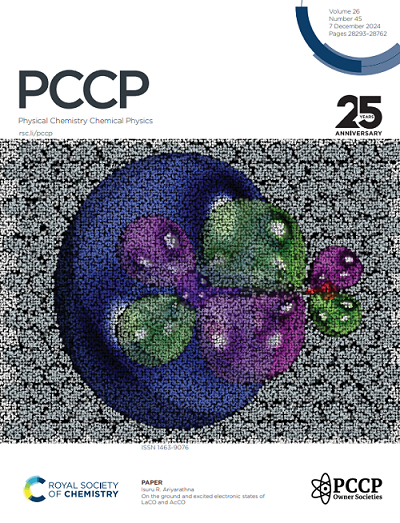过渡金属单原子锚定在Mo2C MXenes上增强氢氧化反应:密度泛函理论研究
IF 2.9
3区 化学
Q3 CHEMISTRY, PHYSICAL
引用次数: 0
摘要
碱性阴离子交换膜燃料电池(aemfc)作为一种很有前途的能量转换装置受到了广泛的关注,但其发展仍然受到用于氢氧化反应(HOR)的高效无铂电催化剂的缺乏的阻碍。本文采用第一性原理密度泛函理论(DFT)计算方法,系统地研究了Mo2C (TM-Mo2C, TM = Fe, Co, Ni, Cu, Zn, Ru, Rh, Pd, Ag, Ir, Pt)负载的过渡金属单原子的HOR催化性能。理论计算表明,TM原子与Mo2C衬底的集成调节了电子结构,并建立了由TM和相邻Mo原子组成的双活性位点。这种协同结构优化了关键中间体(H*和OH*)的吸附自由能,从而调节了HOR的活性。发现TM-Mo₂C的催化活性与H*和OH*的吸附自由能呈火山状关系。值得注意的是,由于其平衡的H*和OH*吸附强度,Ru-Mo₂C对HOR具有超低的自由能垒,表现出优异的催化性能。此外,Ru-Mo2C具有良好的热力学和电化学稳定性,这主要得益于其负的形成能和高的氧化电位。这些发现突出了Ru-Mo₂C作为aemfc的高性能HOR催化剂的前景,为合理设计高效的无pt电催化剂提供了理论指导。本文章由计算机程序翻译,如有差异,请以英文原文为准。
Transition metal single-atoms anchored on Mo2C MXenes for enhanced hydrogen oxidation reaction: a density functional theory study
Alkaline anion-exchange membrane fuel cells (AEMFCs) have garnered significant attention as promising energy conversion devices, yet their development remains hindered by the scarcity of efficient platinum-free electrocatalysts for the hydrogen oxidation reaction (HOR). Here, we systematically investigated the HOR catalytic performance of transition metal single-atoms supported by Mo2C (TM-Mo2C, TM = Fe, Co, Ni, Cu, Zn, Ru, Rh, Pd, Ag, Ir, Pt) using first-principles density functional theory (DFT) calculations. Theoretical calculations indicate that the integration of TM atoms with Mo2C substrates modulates the electronic structure, and establishes dual active sites comprising TM and adjacent Mo atoms. This synergistic configuration optimizes the adsorption free energies of key intermediates (H* and OH*), thereby regulating HOR activity. Volcano-shaped relationships are identified between the catalytic activity of TM-Mo₂C and the adsorption free energies of H* and OH*. Notably, Ru-Mo₂C exhibits ultralow free energy barriers for HOR due to its balanced H* and OH* adsorption strengths, demonstrating superior catalytic performance. Additionally, Ru-Mo2C shows excellent thermodynamic and electrochemical stability, supported by its negative formation energy and high oxidation potential. These findings highlight Ru-Mo₂C as a promising high-performance HOR catalyst for AEMFCs, offering theoretical guidance for the rational design of efficient Pt-free electrocatalysts.
求助全文
通过发布文献求助,成功后即可免费获取论文全文。
去求助
来源期刊

Physical Chemistry Chemical Physics
化学-物理:原子、分子和化学物理
CiteScore
5.50
自引率
9.10%
发文量
2675
审稿时长
2.0 months
期刊介绍:
Physical Chemistry Chemical Physics (PCCP) is an international journal co-owned by 19 physical chemistry and physics societies from around the world. This journal publishes original, cutting-edge research in physical chemistry, chemical physics and biophysical chemistry. To be suitable for publication in PCCP, articles must include significant innovation and/or insight into physical chemistry; this is the most important criterion that reviewers and Editors will judge against when evaluating submissions.
The journal has a broad scope and welcomes contributions spanning experiment, theory, computation and data science. Topical coverage includes spectroscopy, dynamics, kinetics, statistical mechanics, thermodynamics, electrochemistry, catalysis, surface science, quantum mechanics, quantum computing and machine learning. Interdisciplinary research areas such as polymers and soft matter, materials, nanoscience, energy, surfaces/interfaces, and biophysical chemistry are welcomed if they demonstrate significant innovation and/or insight into physical chemistry. Joined experimental/theoretical studies are particularly appreciated when complementary and based on up-to-date approaches.
 求助内容:
求助内容: 应助结果提醒方式:
应助结果提醒方式:


